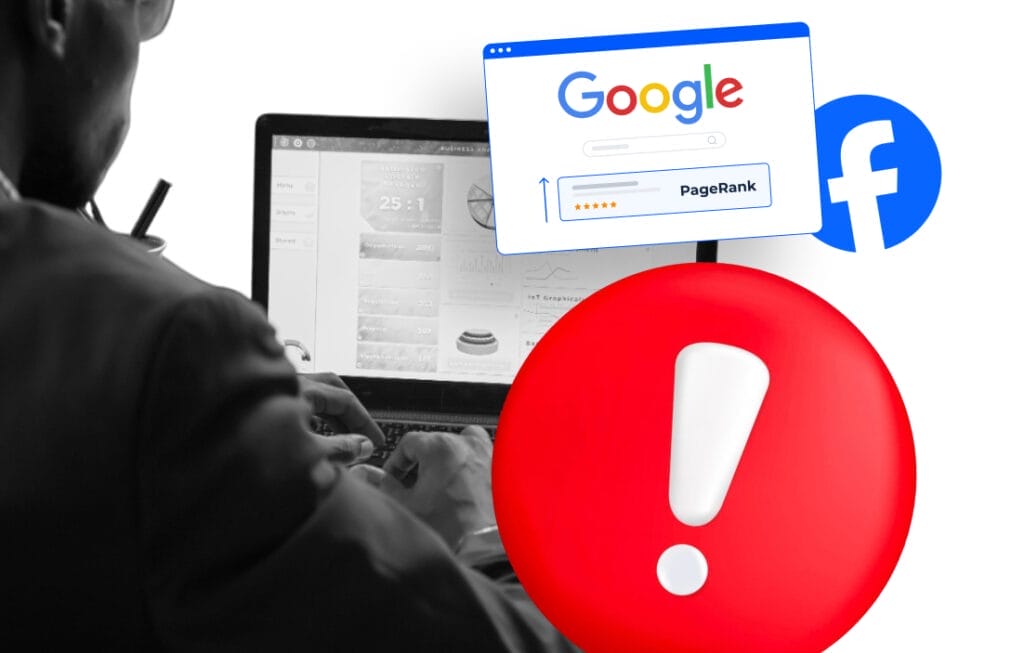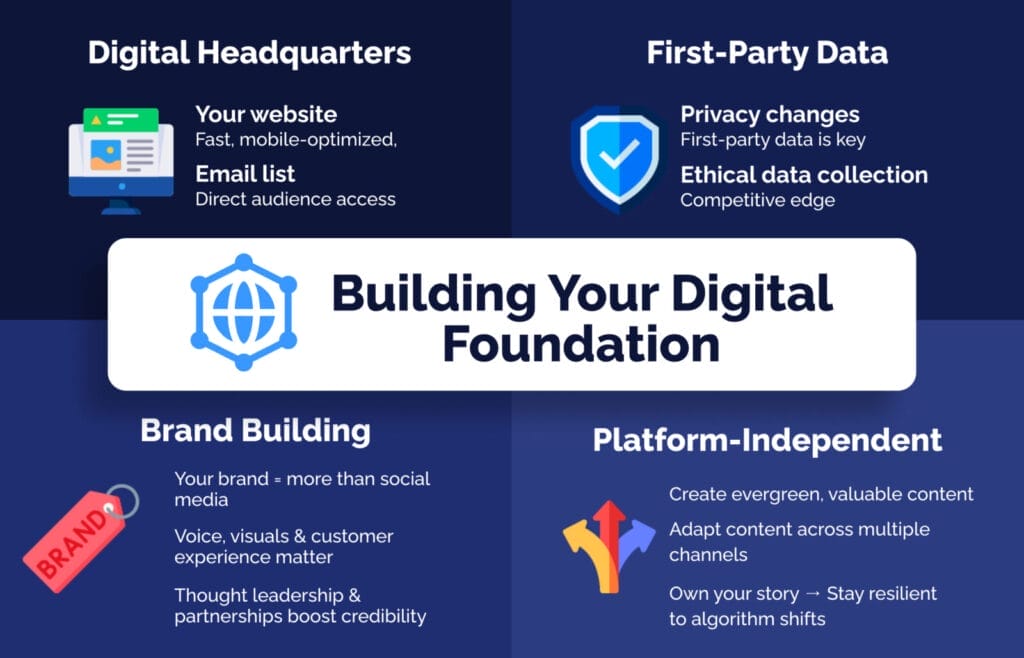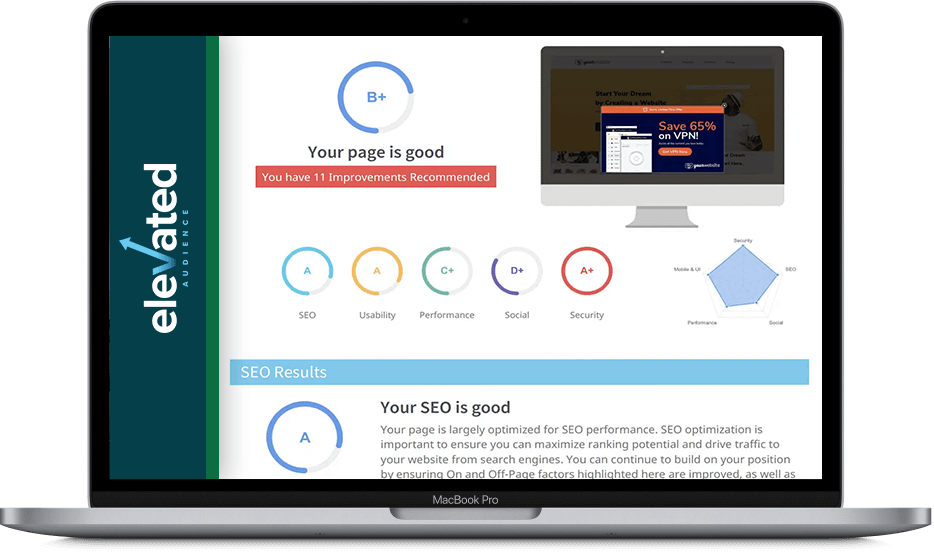Too many businesses rely too heavily on Google and Facebook because they’re familiar and “safe” choices. But this is risky—it’s like building your house on someone else’s land. They can change the rules anytime they want.
In recent years, the tech giants have created seismic shifts. Apple’s privacy changes have upended Facebook’s targeting capabilities, and Google’s push toward AI-generated search results has threatened organic visibility.
I get it; Google and Facebook feel like safe bets. But when you build your entire marketing strategy on rented land—whether it’s Google’s search results or Meta’s social networks—you essentially give these platforms complete control over your business’s future.
There’s a more robust approach that I’ve found to be successful: creating a diversified, platform-agnostic marketing strategy that puts you back in control.
The strategy isn’t just about risk management—it’s about building a marketing foundation that grows stronger with time, regardless of which platforms rise or fall.

The Hidden Dangers of Platform Dependency
The allure of established platforms like Google and Facebook is undeniable. They offer massive audiences and trusted targeting tools.
Sure, that seems great and all. But this convenience comes with big risks that many businesses learn about the hard way—myself included.
Algorithm Volatility and Sudden Traffic Drops
Meta’s algorithm changes regularly impact business page visibility. Many of my clients have experienced dramatic drops in organic reach overnight after platform updates.
Similarly, Google’s core updates routinely reshape the search landscape. I’ve had many business owners come to me who, once ranked on page one, struggle to maintain visibility, often with no clear path to recovery after algorithm updates.
Rising Advertising Costs and Declining Organic Reach
Advertising costs are skyrocketing.
I’ve watched CPCs climb faster than my coffee budget, and trust me, that’s saying something.
Every year, we’re all competing for the same ad space, except now there are twice as many of us bidding for it.
As for organic reach, it’s become about as rare as a perfect Google PageSpeed score. Your business page could have 10,000 followers, but these days, it’s impressive to reach about 200.
Platform-Specific Audience Limitations
Each platform speaks its own language.
LinkedIn’s professional and business-like content won’t reach the audience on TikTok, where people want to watch funny and mindless content.
Facebook is becoming the digital equivalent of a family reunion, and Instagram is that trendy art gallery downtown.
I’m not suggesting you abandon ship on these platforms. Think of them as instruments in your marketing orchestra. Individually, they each play their own tune, but together—when conducted properly—they create something much more powerful.
The key is building a strategy that uses each platform’s strengths while protecting yourself from their mood swings.

Building Your Digital Foundation
Every resilient marketing strategy needs to be built on assets and data you actually own and control.
Consider my aforementioned reference: You want to build your house on land you own rather than renting space in someone else’s building.
Your Digital Headquarters
Your website is command central—the one place where algorithms can’t change the rules on you overnight. It needs to be fast (because, let’s face it, nobody waits anymore), mobile-optimized, and laser-focused on your business goals.
When paired with a strategic email list, you have direct access to your audience without playing the platform lottery.
Unlike paid advertising that vanishes when you stop feeding the meter, these owned assets appreciate over time, building real digital equity for your business.
First-Party Data: Strategic Asset
Privacy changes are reshaping how we collect data and user signals, and first-party data has become marketing gold. I’ve seen businesses transform their results by implementing smart, ethical data collection systems that create insights no platform can match.
The key is to build transparent practices that respect user privacy while gathering actionable intelligence.
When managed properly, this data becomes your competitive edge—one that gets sharper with every customer interaction, regardless of what the tech giants decide to do next.
Brand Building Beyond Platforms
Your brand is more than your social media presence—it’s the total experience people have with your business. This means developing a distinct voice and visual identity that works across all channels while creating memorable customer experiences that people want to talk about.
You want to leverage your channels symbiotically.
True brand building happens through meaningful interactions with your industry and community, whether through thought leadership, speaking engagements, or strategic partnerships.
When your brand stands strong on its own, it creates recognition and trust that transcends any single platform or channel.
Creating Platform-Independent Content Strategies
Design content that remains valuable regardless of where it appears. This means developing cornerstone content that answers fundamental questions in your industry and then adapting it thoughtfully across different formats and channels.
Focus on evergreen topics that maintain relevance over time, always building around customer needs rather than platform features.
A single piece of valuable content can take many forms:
- a detailed guide on your website
- a video series
- an email course
- social media discussions
But, the core value proposition remains consistent.
Consider your content operation like a media company (minus the coffee-fueled newsroom).
Focus on creating assets that build long-term value while meeting immediate marketing needs. When you own both the story and how it’s told, algorithm updates become less of a headache and more of a footnote in your content strategy.

Diversifying Your Digital Presence
Smart diversification means more than just creating profiles on every available platform. It requires strategic thinking about where your audience spends time and how different channels can complement each other.
Emerging Platforms and New Opportunities
TikTok has changed marketing strategies. I’ve seen traditionally conservative brands find surprising success there.
The key?
Authenticity wins over polished perfection.
LinkedIn has grown from its resume-collection days to become a B2B powerhouse. Meanwhile, Pinterest quietly drives purchase decisions like a well-oiled machine, especially in visual-first industries.
Alternative Traffic Sources
Some of the most valuable conversations happen away from the social media spotlight.
Reddit’s communities are like specialized groups of people passionate about a specific topic—when you contribute genuinely, the engagement is incredible.
In that same vein, Facebook Groups have become the new town squares, where real discussions happen away from the noise of news feeds.
And podcasts? They’re like one-on-one conversations with your audience during their most personal moments.
Strategic Partnerships and Cross-Promotions
Partnership marketing creates win-win scenarios in which brands collaborate to access established audiences. This might mean co-creating content with complementary brands, appearing on industry podcasts, or developing joint promotional campaigns.
The key is finding partners whose audiences overlap with yours but aren’t direct competitors. These relationships can extend your reach while building credibility through association with trusted brands.
Offline-to-Online Integration
Despite the digital focus, physical world touchpoints remain powerful marketing opportunities.
QR codes can bridge offline materials to digital experiences. Live events can generate content for multiple channels while building personal connections. Even traditional media like print or radio can drive online engagement when integrated thoughtfully.
The most effective strategies create seamless experiences that move naturally between offline and online interactions, meeting customers wherever they are most comfortable.

The Omnichannel Advantage
Modern customers don’t think in channels—they expect consistent experiences across social media, your website, and in-store interactions. The power of omnichannel marketing lies in orchestrating these touchpoints into a cohesive journey.
Creating Seamless Customer Experiences
A customer might discover you on Instagram, research on YouTube, join your email list, and purchase through your website. Each interaction should feel like one continuous conversation.
For example, if someone abandons their cart on a desktop, they should be able to complete the purchase on mobile without starting over.
These seamless experiences build the trust that drives loyalty.
Cross-Platform Attribution and Tracking
Key elements that I’ve relied on—and you should, too—in cross-platform tracking are:
- UTM parameters across campaigns to track traffic sources
- Cross-domain tracking to understand customer journeys
- Unique phone numbers (I recommend CallRail for call tracking) or promo codes to measure offline conversions
- Heat mapping tools for understanding cross-device behavior
- Multi-touch attribution to credit all influential channels
Unified Messaging Across Channels
Your brand voice might be casual on TikTok and professional on LinkedIn, but the core message should stay consistent. This alignment extends to customer service, sales, and every touchpoint.
When launching campaigns, make sure your message translates effectively across platforms while maintaining its essential truth.
Marketing Automation and Integration Tools
Smart automation connects your marketing platforms into workflows that feel personal to customers. Email platforms link with CRM systems, social media syncs with content calendars, and customer service shares data with marketing tools. The right technology stack creates efficient systems that scale personalized experiences.
Remember: Success isn’t about mastering individual channels—it’s about making them work seamlessly together for your customers.
Smart Risk Management
Every marketing strategy carries risk.
Don’t avoid it.
Be prepared when platforms throw their inevitable curveballs.
Budget Strategy That Protects You
I’ve found the 70-20-10 approach keeps you both stable and agile: 70% of your budget goes to what’s already working (your bread and butter), 20% tests promising opportunities (your educated bets), and 10% explores emerging platforms (your calculated risks).
Think of it as your marketing investment portfolio.
Here’s an expert tip: never let a single platform eat up more than 40% of your budget. I’ve seen too many businesses learn this lesson after a Google update or Facebook policy change decimated their primary channel. Keep your risks calculated and your options open.
Performance Monitoring and Reallocation
Monitor key metrics daily but make strategic decisions monthly. Track more than just surface-level metrics like clicks and impressions.
Go deeper with indicators like customer acquisition cost, lifetime value, and platform-specific ROI. When performance drops on one channel, have preset thresholds that trigger budget reallocation to better-performing alternatives.
This responsive approach helps maintain consistent results even when individual channels underperform.
Crisis Management Planning
Develop response plans for common platform disruptions, such as algorithm changes, ad account suspensions, or viral PR issues.
Document a backup plan for each major marketing channel, including alternative platforms ready to scale up if needed.
Maintain relationships with platform representatives and reserve an emergency budget for unexpected challenges.
Testing and Optimization
Run small, continuous tests across channels rather than betting big on single experiments.
A/B tests crucial elements like ad creative, landing pages, and email sequences. Use the insights from better-performing channels to improve weaker ones.
Focus on incremental improvements that compound over time rather than searching for dramatic breakthroughs.
Implementation Guide
I’ve created a guide to help you transform your marketing strategy from platform-dependent to truly diversified.
- Audit Your Current Dependencies: Start by mapping all revenue sources by platform, including organic and paid channels. Calculate the percentage of business dependent on each platform and identify which areas would cause the most disruption if suddenly changed or lost. Document all automation and integrations that rely on specific platforms.
- Set Expansion Priorities: Identify 2-3 new channels where your audience is already active but you’re not. Set clear test budgets and success metrics for each new channel before launching. Choose channels that complement rather than duplicate your existing efforts.
- Structure Your Team: Assign clear ownership for each marketing channel while ensuring cross-training to prevent knowledge silos. Evaluate current team skills against future needs and identify gaps. Consider whether to hire specialists or train existing team members for new channel management.
- Create Your Timeline: Begin with a 12-month outlook, breaking initiatives into quarterly goals. Start with quick wins in Q1 while building toward larger changes. Set specific revenue and growth targets for each quarter, with clear milestones to measure progress. Maintain flexibility to adjust based on early results.
Future-Proofing Your Marketing
Your marketing strategy needs to work like a well-balanced portfolio. While Google and Facebook remain important players, true resilience comes from building a marketing ecosystem you control.
The digital landscape will keep evolving. But here’s what won’t change: the value of owned assets, diverse revenue streams, and adaptable strategies.
Building these foundations doesn’t just protect you from the next algorithm update—it positions you for sustainable growth, regardless of what tomorrow’s platforms look like.
The marketing leaders of tomorrow won’t be the ones who mastered a single platform’s tricks. They’ll be the ones who build flexible, integrated systems that adapt faster than their competitors.
Because in digital marketing, the only constant is change—and the best time to prepare for it is now.


